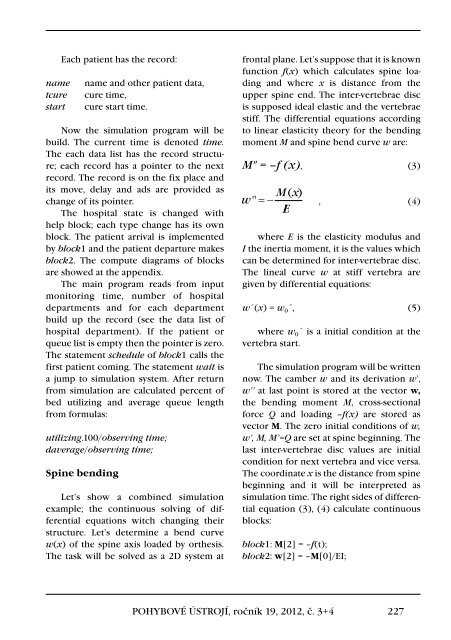3+4+Supplementum/2012 - Společnost pro pojivové tkáně
3+4+Supplementum/2012 - Společnost pro pojivové tkáně
3+4+Supplementum/2012 - Společnost pro pojivové tkáně
- TAGS
- www.pojivo.cz
Create successful ePaper yourself
Turn your PDF publications into a flip-book with our unique Google optimized e-Paper software.
Each patient has the record:<br />
name name and other patient data,<br />
tcure cure time,<br />
start cure start time.<br />
Now the simulation <strong>pro</strong>gram will be<br />
build. The current time is denoted time.<br />
The each data list has the record structure;<br />
each record has a pointer to the next<br />
record. The record is on the fix place and<br />
its move, delay and ads are <strong>pro</strong>vided as<br />
change of its pointer.<br />
The hospital state is changed with<br />
help block; each type change has its own<br />
block. The patient arrival is implemented<br />
by block1 and the patient departure makes<br />
block2. The compute diagrams of blocks<br />
are showed at the appendix.<br />
The main <strong>pro</strong>gram reads from input<br />
monitoring time, number of hospital<br />
departments and for each department<br />
build up the record (see the data list of<br />
hospital department). If the patient or<br />
queue list is empty then the pointer is zero.<br />
The statement schedule of block1 calls the<br />
first patient coming. The statement wait is<br />
a jump to simulation system. After return<br />
from simulation are calculated percent of<br />
bed utilizing and average queue length<br />
from formulas:<br />
utilizing.100/observing time;<br />
daverage/observing time;<br />
Spine bending<br />
Let’s show a combined simulation<br />
example; the continuous solving of differential<br />
equations witch changing their<br />
structure. Let’s determine a bend curve<br />
w(x) of the spine axis loaded by orthesis.<br />
The task will be solved as a 2D system at<br />
frontal plane. Let’s suppose that it is known<br />
function f(x) which calculates spine loading<br />
and where x is distance from the<br />
upper spine end. The inter-vertebrae disc<br />
is supposed ideal elastic and the vertebrae<br />
stiff. The differential equations according<br />
to linear elasticity theory for the bending<br />
moment M and spine bend curve w are:<br />
M" = –f (x), (3)<br />
w ''<br />
M(<br />
x)<br />
−<br />
EI<br />
= , (4)<br />
where E is the elasticity modulus and<br />
I the inertia moment, it is the values which<br />
can be determined for inter-vertebrae disc.<br />
The lineal curve w at stiff vertebra are<br />
given by differential equations:<br />
w´(x) = w 0´, (5)<br />
where w 0´ is a initial condition at the<br />
vertebra start.<br />
The simulation <strong>pro</strong>gram will be written<br />
now. The camber w and its derivation w’,<br />
w’’ at last point is stored at the vector w,<br />
the bending moment M, cross-sectional<br />
force Q and loading –f(x) are stored as<br />
vector M. The zero initial conditions of w,<br />
w’, M, M’=Q are set at spine beginning. The<br />
last inter-vertebrae disc values are initial<br />
condition for next vertebra and vice versa.<br />
The coordinate x is the distance from spine<br />
beginning and it will be interpreted as<br />
simulation time. The right sides of differential<br />
equation (3), (4) calculate continuous<br />
blocks:<br />
block1: M[2] = –f(t);<br />
block2: w[2] = –M[0]/EI;<br />
POHYBOVÉ ÚSTROJÍ, ročník 19, <strong>2012</strong>, č. 3+4 227

















